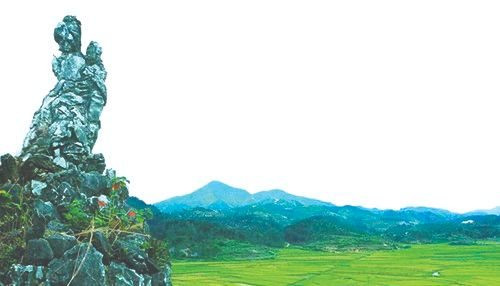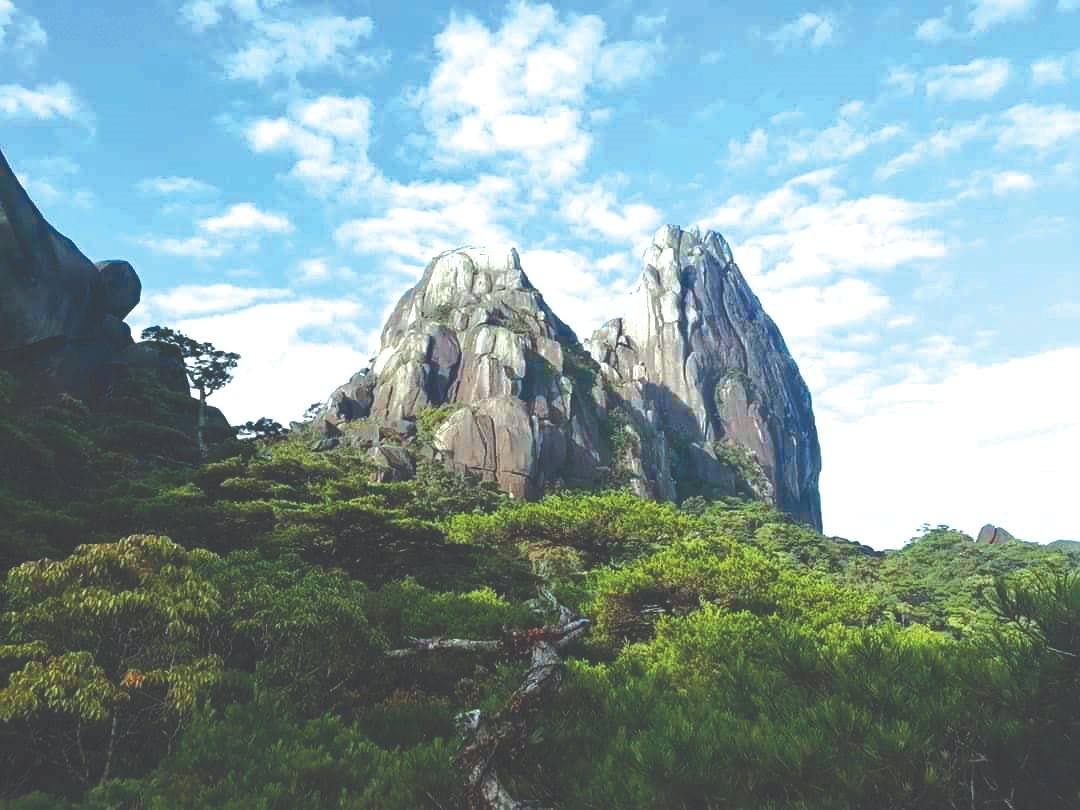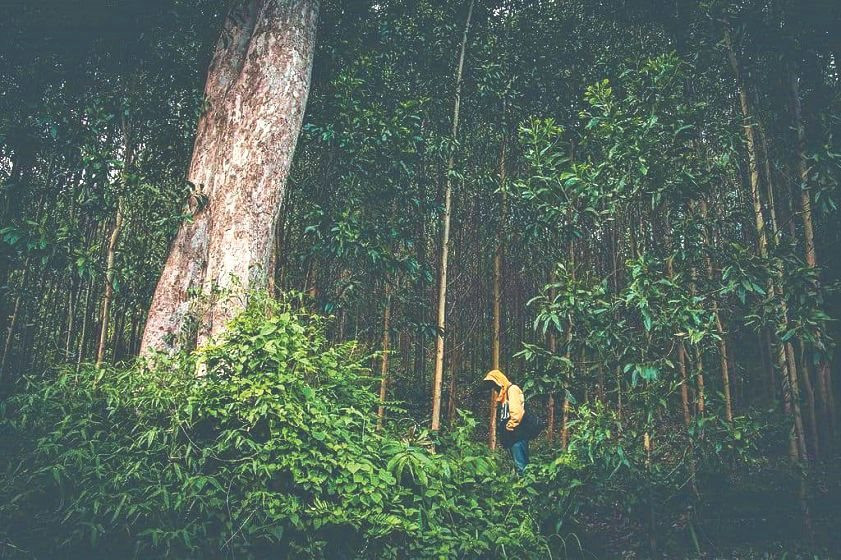Legend of the land of Agarwood
English - Ngày đăng : 11:38, 03/10/2023
Mountain Mau Tu - the sacred
Mountain Mau Tu, also known as Mother Embracing Child, stands out at 2,051 meters amidst hundreds of other mountains. It is situated to the northwest of Ninh Hoa town. The mountain’s peak is flat and devoid of tall trees. There is a large green rock at the top, alongside a rock that’s half the size of the larger one. Clouds enshroud the mountain year-round, creating the image of a woman holding a child from a distance. Hence, the local people refer to it as Mother Embracing Child.

The legend tells that the rock known as Mother Embracing Child used to be a transformed person, while the surrounding rocks were household items and domestic animals. Dissatisfied with the bustling life of the common people, a couple took each other to live on the mountain. After living there for four years, they had a child who grew to be four years old. One day, an old friend who had become an accomplished immortal visited them. Both the hosts and the guest were delighted. The wife busied herself preparing a feast while the husband sat listening to the friend’s teachings about cultivating immortality.
However, the guest mentioned that to seek immortality, one had to burn agarwood and make a plea. The fragrance of agarwood would carry the prayer to the Tam Thanh Palace to fulfill the petitioner’s wish.
The host was instructed that agarwood could be found in the nearby mountains, but to preserve his life, he needed to hold his breath. After a feast of food and wine, the guest fell into a deep sleep. The host then reached into the guest’s bag, took the bundle of agarwood, and quietly left.
Two days and nights later, when the guest woke up and didn’t find the bundle of agarwood, he panicked and searched frantically. Jumping from one mountain to another, he scoured the entire area, but there was no trace of the host. Angry and worried, he slipped and fell from Tinh Son Mountain in Son Hoa region (Phu Yen) and died. The good spirit inside the guest’s bag transformed into a rock, and his bones and flesh turned into old trees.
As for the husband who set out to find agarwood while holding his breath, months and days passed in the deep forested mountains. He longed to return but couldn’t find his way back. Over time, he lost his breath, grew hair all over his body, turned into a gray tiger, roared a few times, and then headed back to his old home to find his wife and child. However, when he arrived, the familiar scene was no longer there.
The wife waited at home, tears streaming down her face. Her body turned into stone under the sun and rain, along with the objects and animals that were transformed into stone alongside her and her child. The streams turned into rivers in the province and neighboring provinces. Among them was a stream called Suoi Tien (Fairy Stream), whose water is always clear and never dries up.

The gray tiger looked at the pitiful scene, roared through the mountains and forests, destroying all the old trees on the mountain before vanishing into the deep woods.
Mountain Mau Tu remains sacred. During the resistance against the French colonialists, the Le Duong battalion marched and temporarily resided on Mountain Mau Tu. A mischievous soldier buried a mine under the stone of Mother Embracing Child and detonated it. The explosion shattered the surrounding rocks and trees, but the stone statue of Mother Embracing Child remained unharmed. As the explosion subsided, the soldier was found dead.
Today, after many years have passed, people still see the towering mountain in the shape of a mother holding her child, waiting for her husband. It not only recalls the legend of the land of agarwood but also evokes the touching story of faithful marital love.
Hon Ba- The Queen of mountain ranges
Hon Ba is also known by its written name, Bich Son, which means Rocky Mountain. Hon Ba was originally considered the “queen” among the mountain ranges in the region. The clustered mountains connect to form a defensive wall, stretching from north to south. Hon Ba stands prominently in the center, towering over all the tall peaks. White clouds and mist shroud it year-round.

In Ninh Hoa, there is also a place called Hon Ba, but it is named so because there is a shrine to Lady Thien Y A Na on the mountain’s summit. In Cam Lam, it is called Hon Ba because it is seen as Lady Thien Y’s Palace. According to legend, every time Lady Thien Y ascends the mountain, there is a long radiance like a strip of silk flowing down the mountain, followed by the sound of three thunderclaps echoing through the forest. However, sometimes there is no thunder, only light emitting from the mountain like a brilliant glow visible for hundreds of miles. People recognize Lady Thien Y’s arrival through these radiant nights with clear moons and cool winds, so they burn incense and agarwood as offerings.
Because of these tales, nobody dares to visit Hon Ba for leisure or exploration due to its lack of accessible paths, dense vegetation, and wild animals in the forest. The rocky mountain is layered and piled up, each layer as solid as a wall.
It wasn’t until 1914 that Dr. Yersin, seeking a place to experiment with the quinine plant, found a way to reach the summit. After discovering that Hon Ba was suitable for the quinine plant, a species capable of surviving at elevations of 1,500 meters in the tropical highlands, he established an astronomical observatory and a wireless station there.
Even though Hon Ba used to be veiled in mist and smoke, about 50 kilometers from Nha Trang, the journey was fraught with difficulties. Despite the small trail Dr. Yersin opened from Suoi Dau to the mountain’s base and the road expansion permitted by the French government that allowed cars to travel, reaching the summit still required a six-hour hike from the mountain’s base. The road was challenging, but the cool climate and serene scenery provided a delightful and enjoyable journey.
With frequent rain in this area, the dense forest features tall trees, orchids clinging to branches, and wild strawberries surrounding Dr. Yersin’s camp. During spring, hundreds of thousands of vibrant flowers blossom, filling the deep forest with a captivating fragrance.
Today, despite the increasing number of tourists visiting Hon Ba, the place still maintains its pristine beauty. At the mountain’s peak, Dr. Yersin’s two-story wooden house still stands, along with ancient tea trees, horse stables, and gatherings of exotic bird species rarely seen elsewhere.
The breathtaking view of Hon Ba remains magnificent, with the eastern side reflecting the mercury-colored sea and the southern and northern mountain ranges merging with the green valley and coastal plains. At night, beneath the moonlight, the green waves of the forest trees mingle with the shimmering waves of the open sea, creating an enchanting blend of reality and dream.
